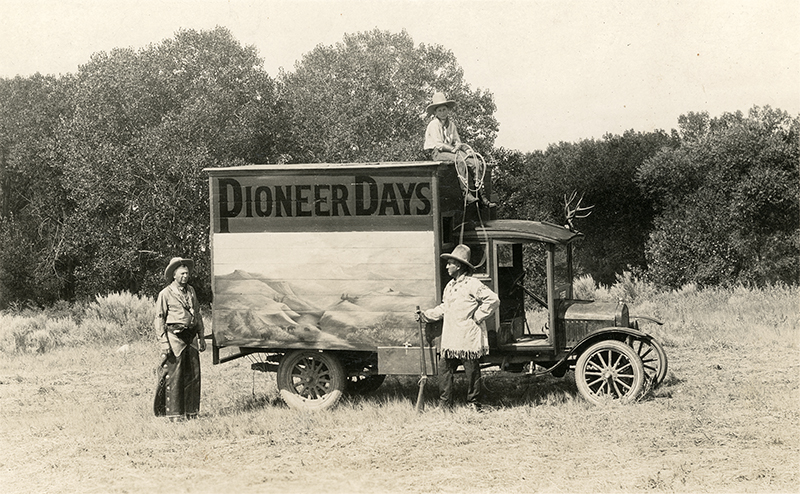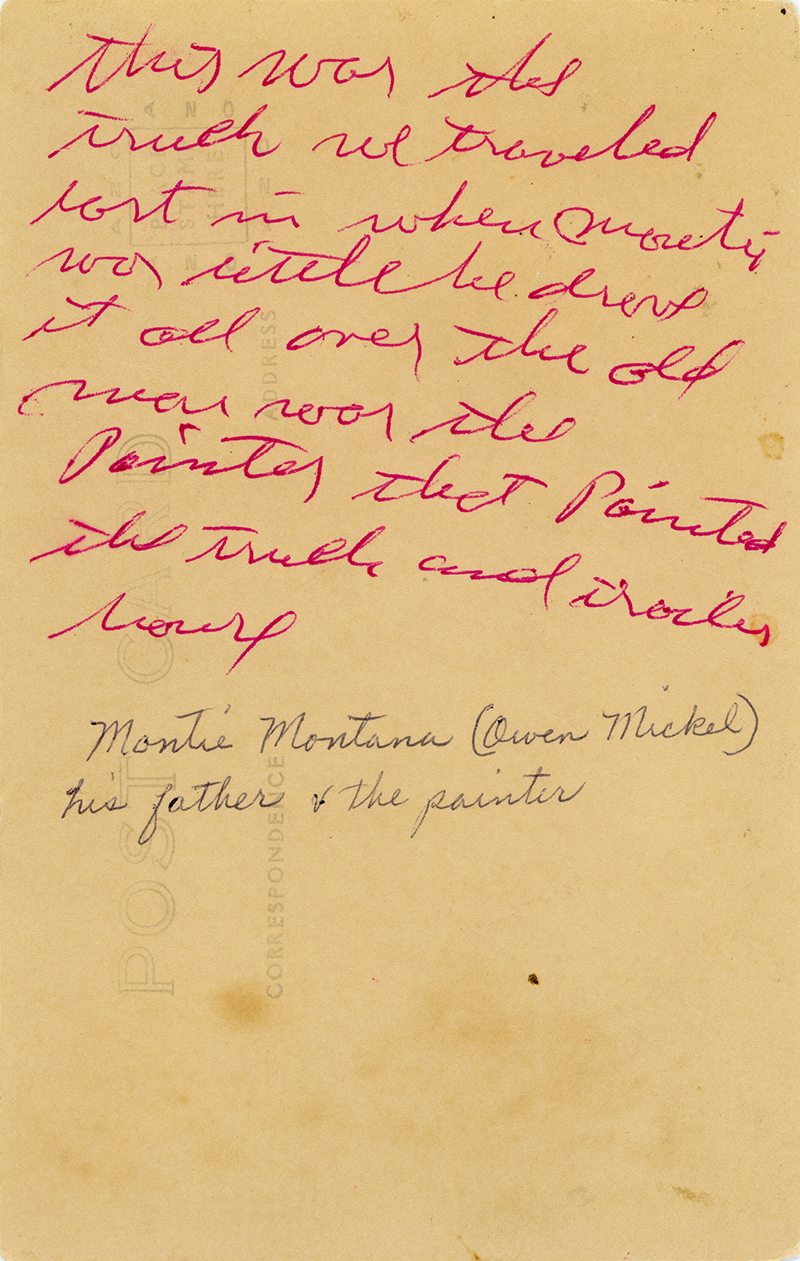Montie Montana & Father with First Touring Wagon
Entertainer, Future Agua Dulce Resident

Click image to enlarge
| Download archival scan
Not quite 15-year-old Owen H. Mickel — the future Montie Montana — sits atop his family's first touring wagon in Miles City, Montana, in early 1925. Montie's father, Edgar Owen "E.O." Mickel, stands at left. The artist who painted the wagon, a Mr. Morrison, stands at right. Silver albumen real-photo postcard print, 3½x5½ inches. Ex-Montie Montana collection. Montie reproduced the image on page 31 of his 1993 autobiography, "Not Without My Horse!" According to Montie's widow Marilee Montana and grandson Ryan (pers. comm. 2022), Montie's father wrote the inscription on the back (see below). In red ink, it reads:
This was the truck we traveled east in when Montie was little. He drove it all over. The old man was the painter that painted the truck and trailer house.
In his autobiography, Montie remembers that the family spent much of 1924 in Iowa selling wild horses they had rounded up in Montana. Then,—
In the spring of 1925, we went back to Miles City and Dad had a brainstorm. He bought a 1923 Ford truck and built living quarters on it. He had a Western artist whose name was Mr. Morrison paint an Old West scene on the sides and the rear. Actually, my dad had invented the first motor home, some thirty-five years or so ahead of its time [op cit.:24].
That summer, Montie got his first rodeo job and was introduced for the first time as "Montie, the Montana Kid." As they took their show on the road — Dad giving talks on the Old West and showing his magic lantern slides, and Montie displaying his agility with a rope — Montie did the driving "because Dad couldn't get the hang of our stick shift with 15 gears and 2 transmissions" [ibid.:25].
We'd stop occasionally to visit relatives, and some of them didn't think too kindly of us parking our motorhome with its colorful painted Western scenes in their front yard for all the neighbors to see. I know they all thought that we were just dreamers and would never amount to much. [...] One day, as we were leaving Fargo, North Dakota, I made a wrong turn and went about a mile up a hill. When we passed the hospital, we knew we had to turn around and go back. On the way down the hill, the transmission got stuck in one gear, and I couldn't get it out. My dad, riding next to me, thought he'd help. He jerked it out of gear, but didn't put it in a new gear, so we were free wheeling down the hill. Dad got excited and turned off the key, so now with no brakes, we had a wild ride all the way back to town, with Dad, Mother and me leading into each curve to keep the car from flipping over [ibid.:25-26]. The little family had another close call one night in East St. Louis during the winter of 1925-26, nearly suffocating when they left the kerosene stove lit inside the wagon at bedtime. The following day, the vehicle got stuck on the St. Louis Bridge with a frozen radiator.
Dad had enough! He got rid of our house car then and there. He traded it for a 490 Chevrolet touring car, and we headed for California [ibid.:26].
About Montie Montana
Born Owen H. Mickel, Montie (June 10, 1910 - May 20, 1998) traveled with his dad, E.O. [Edgar Owen] Mickel, and mother [Mary Edna Harlan Mickel]. Billed as the Montana Cowboys, they did whip and rope acts and put on a slide show about the American West. In 1929 while working the Buck Jones Wild West Show, the announcer could not remember his name, so he announced him as Montie from Montana, and as Montie tells us in his autobiography, "the crowd loved it and so did I." From then on he became known as Montie Montana. As a star of silver screen, stage and rodeo arena, Montie entertained audiences around the world for more than 70 years. He rode in 60 consecutive Rose Parades and is famous for roping President Eisenhower in the 1953 Inaugural Parade. From 1945 to 1965 Montie thrilled over 8 million school children with his stagecoach and horse, Rex. Montie was famous for riding his horses into equally famous places such as the top of the Empire State Building, the Beverly Wilshire hotel in Beverly Hills, the Brown Palace in Denver, the Broadmoor in Colorado Springs and top-level government offices across the country. Though he received hundreds of awards and honors during his extraordinary lifetime, he remained a cowboy at heart. Montie was deeply grateful that he could make a living doing what he loved best — and it showed. He had the most wonderful laugh and was always smiling. An avid collector of Western artifacts, he kept treasures from early on in his career and enjoyed them throughout his life. His legacy will live on with the stories captured in this autobiography where he tells us that he lived in a great era, from the horse and buggy to the space age. Although he has ridden on ahead, I know that he's in tall cotton with other great Western heroes up there and that his horses are knee deep in green pastures and that he's still a cowboy, because he always said, "I must have been born a cowboy because I've never thought of being anything else." Further reading: Read more about Montie Montana here.
LW3806: 9600 dpi jpeg from original photograph purchased 2022 by Leon Worden.
|

